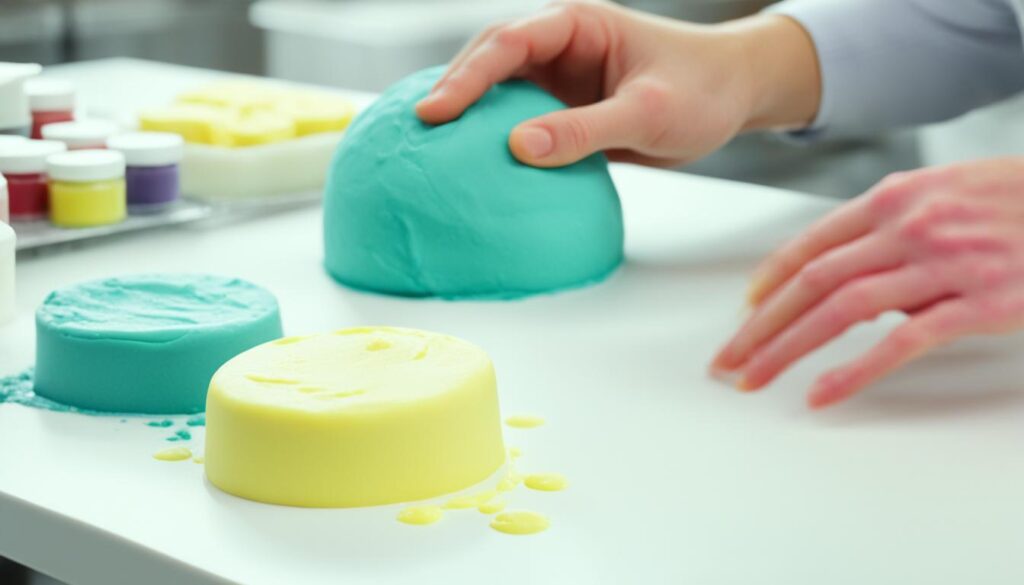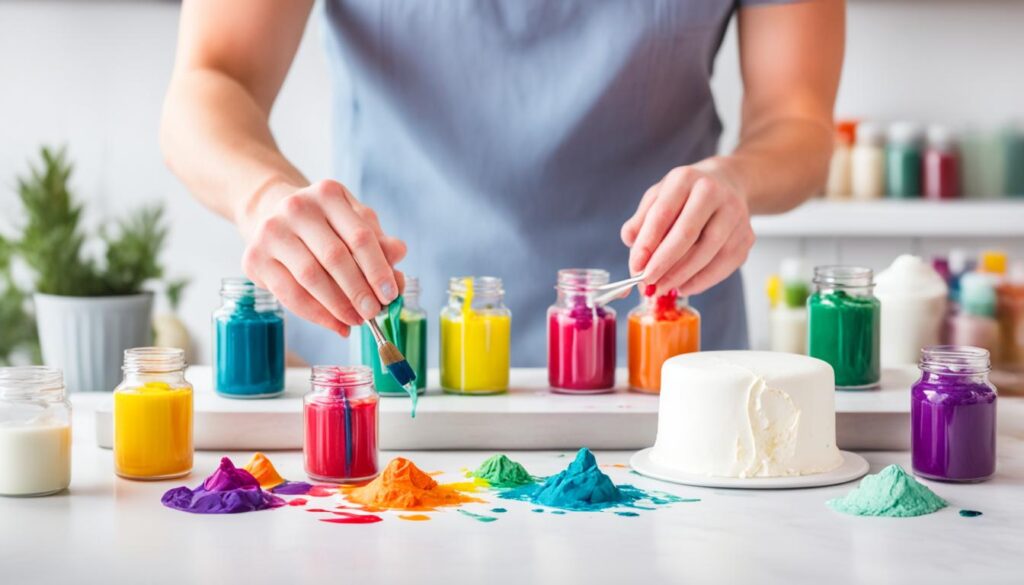Coloring fondant can be a fun and creative way to enhance your cake decorating skills. Whether you’re a beginner or an experienced baker, learning the best techniques for coloring fondant can help you achieve beautiful and vibrant results. In this article, we will explore various methods and tips for coloring fondant, including using food coloring, recommended tools, and how to achieve different shades and colors.
Key Takeaways:
- Discover effective methods for coloring fondant
- Learn professional fondant coloring techniques
- Get tips and tricks for coloring fondant with food coloring
- Find out the best way to color fondant
- Explore easy fondant coloring tips
Note: The image is placed here right after the introduction to maintain relevance to the topic and provide visual appeal to the readers.
Using Food Coloring
One of the most common methods of coloring fondant is using food coloring. While there are different types of food coloring available, it is recommended to use gel coloring for fondant as it incorporates evenly and easily. Liquid food coloring or natural food coloring can make the fondant sticky and messy. It’s best to start with a small amount of food coloring and gradually add more to achieve the desired color intensity. Wilton brand gel food coloring is a popular choice among bakers for coloring fondant.
Why Choose Gel Food Coloring?
Gel food coloring is the preferred choice for coloring fondant due to its unique properties. Unlike liquid food coloring, which can dilute the fondant and make it too sticky or runny, gel food coloring is more concentrated and can be easily incorporated into the fondant without altering its texture. The thicker consistency of the gel coloring allows for better control over color intensity, making it easier to achieve vibrant and consistent shades.
Tips for Using Gel Food Coloring
When using gel food coloring to color fondant, it’s important to keep the following tips in mind:
- Start with a small amount of gel food coloring and gradually add more as needed. It’s easier to darken the color than to lighten it.
- Use a toothpick or a small food-safe paintbrush to add the gel coloring to the fondant. This allows for more precise control over the amount of coloring added.
- If you need to achieve a specific shade or color, it’s helpful to have a color chart or guide to reference. This can help you mix the right proportions of different gel food colors to get the desired result.
Experimenting with Color Combinations
Don’t be afraid to experiment with different color combinations when using gel food coloring to color fondant. Mixing different shades can help you achieve unique and customized colors for your cake decorations. Keep in mind that some colors may intensify over time, so it’s best to let the colored fondant rest for a few hours before using it.
Remember, practice makes perfect when it comes to coloring fondant. Don’t be discouraged if you don’t achieve the desired results on your first attempt. With time and experience, you’ll develop your own techniques and discover the perfect color palettes for your cake designs.
Step-by-Step Guide to Coloring Fondant
To color fondant, you will need white fondant, food coloring of your choice, toothpicks, a paring knife, and a rolling mat. Follow these simple steps to achieve a beautifully colored fondant:
- Cut an appropriate-sized piece of white fondant for the specific color you need. Make sure you have enough fondant to cover your cake or create your desired decorations.
- Using a toothpick or knife, add a small amount of food coloring to the fondant. Start with a minimal amount as you can always add more later to deepen the color.
- Fold the fondant over the coloring and start twisting and stretching it. This will help distribute the color evenly throughout the fondant. Continue twisting and stretching until you achieve a uniform color.
- Be careful not to let the coloring touch your skin as it can stain. Consider wearing gloves for added protection.
- If you’re looking to create a marbled effect or mix multiple colors, gently knead the fondant until the colors are blended together.
- If the color isn’t intense enough, add more food coloring and repeat the twisting and stretching process.
By following this step-by-step guide, you can easily achieve a uniform and vibrant color for your fondant.
Tips for Achieving Uniform Colors:
Here are some additional tips to help you achieve the best results when coloring fondant:
- Start with a small amount of food coloring and gradually add more to control the intensity of the color.
- Use gel food coloring instead of liquid food coloring for better consistency and ease of blending.
- Experiment with different color combinations by mixing primary colors to create custom shades.
- If you accidentally add too much food coloring and the fondant becomes too sticky, add a small amount of powdered sugar to balance the consistency.
- Remember to clean your tools and work area promptly to prevent color transfer and staining.
By following these tips and techniques, you can confidently color fondant and achieve the desired shades for your cake decorations. Enjoy the process and let your creativity shine!

Pre-mixed Colors vs. DIY Coloring
When it comes to coloring fondant, you have two options: pre-mixed colors or DIY coloring. Both have their advantages and considerations, depending on your specific needs and preferences.
Pre-mixed Colors
If you’re looking for convenience or need a specific shade or large quantities of certain colors like red or black, pre-mixed fondant colors can be a great choice. They are readily available in stores and save you the time and effort of mixing colors yourself. Pre-mixed colors can help you achieve consistent and reliable results every time.
However, it’s important to note that some pre-mixed colors may have added flavors. While this can add a unique taste to your fondant, it may not pair well with certain cake flavors. If flavor compatibility is a concern for you, it’s advisable to check the ingredient list or opt for DIY coloring.
DIY Coloring
On the other hand, DIY fondant coloring offers you more control and flexibility over the shades and tints you want to achieve. By starting with white fondant, you can easily mix and match different food coloring to create custom colors. This gives you the freedom to experiment and create unique shades that perfectly complement your cake design.
DIY coloring can also be more cost-effective, especially if you only need a small amount of a specific color. By purchasing white fondant and coloring it yourself, you can save money and avoid buying pre-mixed packs that may contain colors you don’t need.
Whether you choose pre-mixed colors or DIY coloring, the key is to consider your desired results, flavor requirements, and budget. Both options have their merits, and it ultimately boils down to personal preference and the specific needs of your cake decorating project.

Pros and Cons of Pre-mixed Colors vs. DIY Coloring
| Pre-mixed Colors | DIY Coloring |
|---|---|
| Convenient and time-saving | Offers more control over shades and tints |
| Consistent and reliable results | Allows for experimentation and unique color creation |
| May have added flavors | Cost-effective, especially for small quantities |
Tips for Achieving Different Colors
Once you have mastered the basics of coloring fondant, you can start experimenting with different techniques to achieve a variety of colors. Here are some valuable tips to help you create stunning shades and tones:
- Color Mixing Tips: When mixing colors, start with a small amount of the desired color and gradually add more until you achieve the desired shade. Remember, it’s easier to darken a color than to lighten it, so start with lighter shades and gradually build up. Use a clean toothpick or fondant tool for mixing to prevent cross-contamination and maintain color purity.
- Deep Colors: If you want to create deep and intense colors, it’s best to use gel food coloring as it has a concentrated pigment. Start with a white or light-colored fondant to ensure the true color of the gel food coloring is visible. Add the gel coloring in small increments, mixing well after each addition. This will allow you to gradually achieve the desired deep color without overpowering the fondant.
- Fading Colors: On the other hand, if you want to achieve a faded or pastel color, it’s important to use a light touch when adding the food coloring. Start with a small amount and gradually increase until you achieve the desired hue. Remember that pastel colors can be more delicate and prone to fading, so it’s best to mix the fondant just before using it to preserve the color.
- Stain Removal: In case of accidental staining, there are a few tricks you can try to remove the stains. Rubbing some vegetable shortening on the stained area and letting it sit for a few hours can help lift the color. Alternatively, you can try using a mixture of lemon juice and salt. Apply the mixture to the stain and gently rub it with a clean cloth. Rinse with water and repeat if necessary until the stain is gone.
By following these tips, you can expand your color palette and create beautiful fondant decorations in a range of shades and tones.
Conclusion
Mastering the art of coloring fondant is a crucial skill that can enhance your cake decorating abilities. By following the step-by-step guide, utilizing the appropriate tools and food coloring, and embracing experimentation with various colors, you can effortlessly create stunning and personalized fondant decorations for your cakes. Remember to practice and enjoy the process of developing your unique color palette. With these expert tips and techniques, you will be able to color fondant with ease and elevate your cake designs to new heights.
FAQ
What is the best way to color fondant?
The best way to color fondant is by using gel food coloring. It incorporates evenly and easily, providing vibrant and consistent results.
Can I use liquid or natural food coloring to color fondant?
It is not recommended to use liquid or natural food coloring for fondant as they can make the fondant sticky and messy. Gel food coloring is a better option.
What tools do I need to color fondant?
To color fondant, you will need white fondant, food coloring, toothpicks, a paring knife, and a rolling mat.
How do I achieve a uniform color when coloring fondant?
Start by adding a small amount of food coloring to the fondant. Fold the fondant over the coloring and twist and stretch it until you achieve a uniform color.
Can I buy pre-mixed colors of fondant?
Yes, you can buy pre-mixed colors of fondant, which can be convenient for specific shades or large quantities. However, be aware that some pre-mixed colors may have added flavors that may not pair well with certain cake flavors.
Is DIY coloring more cost-effective than buying pre-mixed fondant?
For most colors, it is more cost-effective to purchase white fondant and color it yourself. This allows you to create custom tints and shades, giving you more flexibility in your cake decorating.
Are there any tips for achieving different colors with fondant?
Yes, here are some tips: start with a small amount of coloring and gradually add more to achieve the desired intensity, experiment with different color combinations to create unique shades, and have a stain removal solution on hand in case of accidental color transfer.